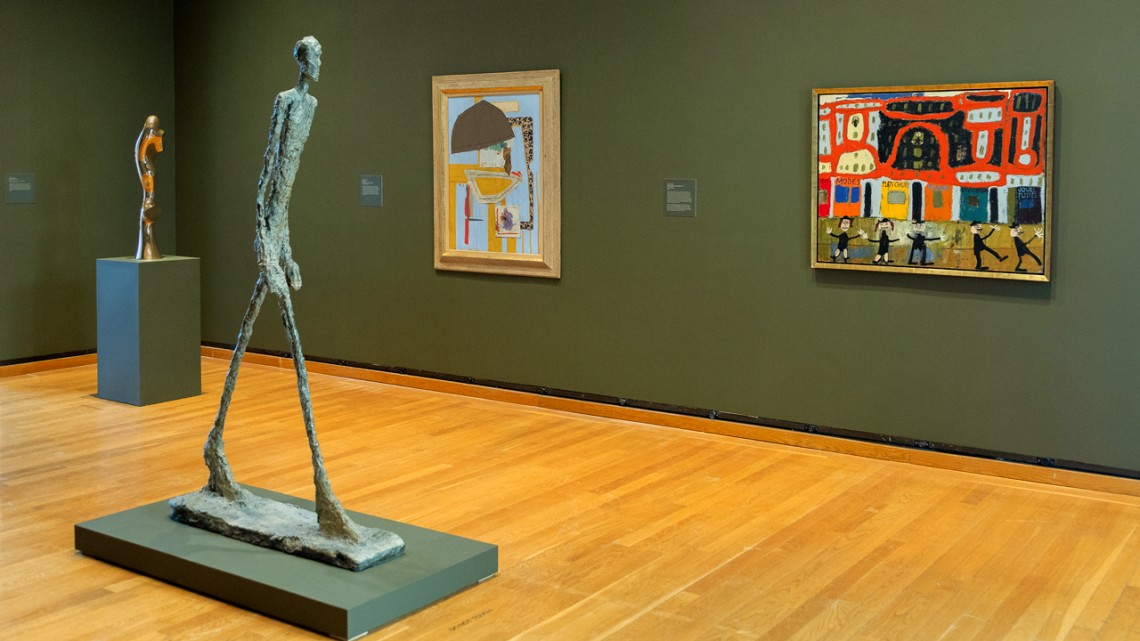
“Walking Man II” by Alberto Giacometti with a sculpture by Jean Arp and paintings by Robert Motherwell and Jean Dubuffet.
Gift brings Calder, Dubuffet, Kandinsky works to Johnson Museum
By Andrea Potochniak
In 2002, the Herbert F. Johnson Museum of Art presented a special exhibition, “The David M. Solinger Collection: Masterworks of Twentieth-Century Art,” which included artwork by Joseph Cornell, Wassily Kandinsky, Alexander Calder and dozens of other modern artists. More than two decades later, nine of those exhibited works have become part of the Johnson Museum’s permanent collection, through the bequest of David Solinger, Class of 1926, and Betty Ann Besch Solinger.
“This phenomenal gift of paintings, sculpture and works on paper – more than 20 years in the making – blossomed from a deep friendship between the Solingers and Frank Robinson, the museum’s former director,” said Jessica Levin Martinez, the Richard J. Schwartz Director of the Johnson Museum. “Thanks to the extraordinary generosity of the Solinger family, these stellar works will inspire new teaching and research, and elevate the entire collection in so many ways.”
The gift is showcased as part of an ongoing installation on view on the museum’s first floor, curated by Andrea Inselmann, the Gale and Ira Drukier Curator of Modern and Contemporary Art at the museum.
“David believed that interest in art, especially for young people, develops from being exposed to it firsthand,” Betty Ann Besch Solinger (1930–2022) wrote in 2002. “He would have been happy that nine works of art from his collection, which he put together with so much love and passion, are being given to the museum in his honor.”
David Solinger (1906–1996) began giving art to Cornell in the 1950s with his first wife, Hope Gimbel Solinger, and helped to found the museum’s Advisory Council, serving as its chair from 1974 to 1988. He also established a museum endowment which has helped to fund close to 1,000 artwork acquisitions.
The nine works of the bequest include several important firsts for the museum’s collection.
The American assemblage artist Joseph Cornell (no relation to Ezra Cornell) was famous for the box constructions that would come to be known by his name. The gift of his “Trade Winds” (1956–58) becomes the first “Cornell box” in the Johnson Museum’s collection.
Early works by Kandinsky and Robert Motherwell are the first unique pieces by the artists in the museum’s collection. The bequest also includes a bronze sculpture by Jean Arp and a steel mobile by Alexander Calder, notable paintings by Jean Dubuffet and Hans Hofmann, and two watercolors by Paul Klee.
A lawyer and veteran of World War II, Solinger took up painting as a hobby and was inspired to begin collecting art; many artist friends were also his clients. In 1956 he became the first president of the Whitney Museum of American Art outside of the Whitney family, and he was a leading figure in its transition from a family museum to an international institution.
“David-the-collector was self-made, not born,” Betty Ann wrote. “He didn’t grow up with art on the walls, and when he went off to Cornell in the 20s, there was only one art course in the curriculum, on Greek sculpture, which he was quick to take.”
Solinger also had a connection to what may be the Johnson Museum’s most well-known acquisition: “L’homme qui marche II (Walking Man II)” by Alberto Giacometti. As chair of the Museum Advisory Council, Solinger helped to secure the gift of the bronze statue from Joanne Uris in 1976, widow of Percy Uris. Percy, his brother Harold D. Uris, and their wives were among Cornell’s first 185 foremost benefactors, their names inscribed on the terrace of Uris Library.
The Giacometti now stands at the center of the current installation, surrounded by more art that came to Cornell through Solinger’s efforts.
Andrea Potochniak is the editorial manager at the Johnson Museum.
Media Contact
Abby Kozlowski
Get Cornell news delivered right to your inbox.
Subscribe
